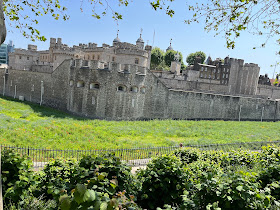 Sitting on the north bank of the River Thames, the Tower of London
was started in 1066 as part of the Norman Conquest. The White Tower was built
by William the Conqueror and became known as a symbol of oppression. With each
successive ruler, additional wards were constructed and the tower expanded.
Sitting on the north bank of the River Thames, the Tower of London
was started in 1066 as part of the Norman Conquest. The White Tower was built
by William the Conqueror and became known as a symbol of oppression. With each
successive ruler, additional wards were constructed and the tower expanded.
During the Wars of the Roses, in the
15th century, the castle was besieged by the Yorks. Princes Edward V
and Richard were held hostage in the tower, then eventually murdered. Check out A Loyal Foe unit study to learn
more about this intriguing story.
This castle was used as a prison
from 1100 to 1952, though the height of its prison use was in the 16th
and 17th centuries. During this time, political and religious
prisoners were locked away, and various forms of torture, including the rack
and manacles, were employed. One political prisoner at the tower was Guy
Fawkes, of the infamous Gunpowder Plot.
The tradition of housing the Crown Jewels
in the Tower of London probably dates from the reign of Henry Ill, when the
jewels and other quality pieces were kept nearby, where they could be pawned
if quick monies were required. One of the pieces on display today is the 800
year old Coronation Spoon, St. Edward's Crown, which is traditionally placed
on the monarch's head at the moment of crowning. |
|
A few interesting notes about the tower - It is said that the ghost of Anne Boleyn haunts the White Tower, carrying her head around in her arm. Also, at least six ravens are kept in the tower at all times, with a ravenmaster. It is believed that if they are absent, the kingdom will fall!
Pick up activities and worksheets to augment your real or virtual trip in the unit study bundle below!
Explore the art, history, geography, food, and culture of England in this cross-curricular unit study….perfect for families getting ready to travel abroad or folks who want to travel via unit studies! Each stop along the roadschooling trip covers a different facet of history and culture with unit information, resources, worksheets, activities, and more...YES! I want 122 pages of FUN STUDIES!
- o Introduction & Geography of England
- o Portsmouth
- o The Mary Rose & naval archaeology
- o London
- o The British Museum & archaeology
- o The Wallace Collection & medieval history
- o The Tower of London / London Bridge & the Tudors
- o Buckingham Palace & royalty
- o Victoria and Albert Museum & medieval art
- o Thames / Globe Theater & Shakespeare
- o Sherlock Holmes Museum & British Literature
- o Abbey Road & British Invasion
- o Leeds
- o Royal Armouries & middle ages
- o York
- o Jorvik & Vikings
- o York Castle & archaeology
- o Haltwhistle
- o Hadrian’s Wall & ancient Celts
- o Vindolanda & archaeology
- o Alnwick
- o Alnwick Castle & architecture
- o Poison Garden & herbs
- o Barter Books & WW2 history
- o Alnmouth
- o North Sea & train history
- o Newcastle o Segedunum & ancient Romans
- o Tips & Tricks for Travelling in England















No comments:
Post a Comment
Note: Only a member of this blog may post a comment.